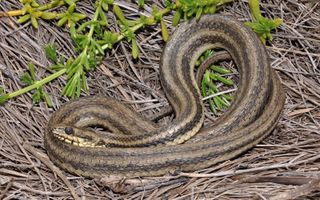Atlantic salt marsh snake: Difference between revisions
mNo edit summary |
No edit summary |
||
| Line 4: | Line 4: | ||
<div class="irlcontenttop"> | <div class="irlcontenttop"> | ||
[[File:Atlantic_salt_marsh_snake.jpg|alt=Atlantic salt marsh snake (Nerodia clarkii taeniata)|thumb|320px|'''[[Atlantic salt marsh snake]]'''<br/> ''Nerodia clarkii taeniata''<br/>Status: [[:Category:Endangered Species|Threatened]]]] | [[File:Atlantic_salt_marsh_snake.jpg|alt=Atlantic salt marsh snake (Nerodia clarkii taeniata)|thumb|320px|'''[[Atlantic salt marsh snake]]'''<br/> ''Nerodia clarkii taeniata''<br/>Status: [[:Category:Endangered Species|Threatened]]]] | ||
<p><i><b>Nerodia clarkii taeniata</b></i>, commonly known as the <b>Atlantic salt marsh snake</b>, is a species of semiaquatic, nonvenomous, colubrid snake found only in the Atlantic coast salt marshes of Volusia and Brevard County, Florida.</p> | <p><i><b>Nerodia clarkii taeniata</b></i>, commonly known as the <b>Atlantic salt marsh snake</b>, is a species of semiaquatic, nonvenomous, colubrid snake found only in the Atlantic coast salt marshes of Volusia and Brevard County, Florida. It is currently listed as a Threatened Species by the US Fish and Wildlife Service.</p> | ||
</div> | </div> | ||
| Line 10: | Line 10: | ||
<h2><span id="Description">Description</span></h2> | <h2><span id="Description">Description</span></h2> | ||
<p>The Atlantic Salt Marsh Snake is a slender, heavily keeled water snake with a pattern of stripes that are variously broken into blotches. The dorsal ground color is pale olive, patterned with a pair of dark brown stripes running down the back and enclosing a pale mid-dorsal stripe. These dark stripes usually become fragmented posteriorly into a series of elongated blotches. There is also a row of dark blotches along the lower side of the body, which may merge to form stripes in the neck region.</p> | <p>The Atlantic Salt Marsh Snake is a slender, heavily keeled water snake with a pattern of stripes that are variously broken into blotches. The dorsal ground color is pale olive, patterned with a pair of dark brown stripes running down the back and enclosing a pale mid-dorsal stripe. These dark stripes usually become fragmented posteriorly into a series of elongated blotches. There is also a row of dark blotches along the lower side of the body, which may merge to form stripes in the neck region.</p> | ||
</div> | |||
<div class="irlcontentbottom noprint"> | <div class="irlcontentbottom noprint"> | ||
==Documents== | ==Documents== | ||
Revision as of 15:15, May 23, 2022
Nerodia clarkii taeniata, commonly known as the Atlantic salt marsh snake, is a species of semiaquatic, nonvenomous, colubrid snake found only in the Atlantic coast salt marshes of Volusia and Brevard County, Florida. It is currently listed as a Threatened Species by the US Fish and Wildlife Service.
Description
The Atlantic Salt Marsh Snake is a slender, heavily keeled water snake with a pattern of stripes that are variously broken into blotches. The dorsal ground color is pale olive, patterned with a pair of dark brown stripes running down the back and enclosing a pale mid-dorsal stripe. These dark stripes usually become fragmented posteriorly into a series of elongated blotches. There is also a row of dark blotches along the lower side of the body, which may merge to form stripes in the neck region.

